Pierogi
Pierogi (/pɪˈroʊɡi/ pih-ROH-ghee)[lower-alpha 1] are filled dumplings made by wrapping unleavened dough around a savoury or sweet filling and cooking in boiling water. They are often then pan-fried before serving.
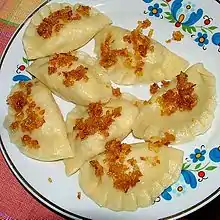 Pierogi ruskie topped with fried onion | |
| Alternative names | Perogie, pirogi, pirohy, pyrohy, varenyky, vareniki, peroge |
|---|---|
| Type | Dumpling |
| Course | Appetizer, main, dessert |
| Region or state | Central Europe, Eastern Europe, Southeastern Europe |
| Serving temperature | warm |
| Main ingredients | Dough: flour, eggs, water Filling: various |
Pierogi are most often associated with the cuisine of Central and Eastern European nations.[lower-alpha 2][1][2][3][4][5][6] Pierogi are also popular in modern-day American and Canadian cuisine, where they are sometimes known under different local names.
Typical fillings include potato, quark, sauerkraut, ground meat, mushrooms, or fruits. Savoury pierogi are often served with a topping of sour cream, fried onions, or both.[7][8]
Terminology
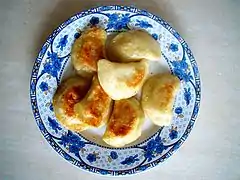
The English word "pierogi" comes from Polish pierogi [pʲɛˈrɔgʲi], which is the plural form of pieróg [ˈpʲɛruk], a generic term for filled dumplings. It derives from Old East Slavic пиръ (pirŭ) and further from Proto-Slavic *pirъ, "feast".[9] While dumplings as such are found throughout Eurasia, the specific name pierogi, with its Proto-Slavic root and its cognates in the West and East Slavic languages, including Russian пирог (pirog, "pie") and пирожки (pirozhki, "baked pastries"), shows the name's common Slavic origins, antedating the modern nation states and their standardized languages. In most of these languages the word means "pie".
Among Ukrainians and the Ukrainian diaspora, they are known as varenyky.[10] The word is the plural form of вареник (varenyk), which derives from Ukrainian вар (var) "boiling liquid", indicating boiling as the primary cooking method for this kind of dumpling. The same term is used in the Mennonite community, sometimes spelled varenikie or wareniki.[11][12]
Bryndzové pirohy is the Slovak term for dumplings filled with sheep milk cheese.[13]
Colțunași is the Romanian term for filled dumplings.[14] It is derived from Greek καλτσούνι, kaltsúni, itself a borrowing from Italian calzoni.
Origin legends
While the origin of the pierogi is often under debate, the exact origin of the dish is unknown and unverifiable. It likely originated somewhere in Central Europe or Eastern Europe, and has been consumed in these regions long before any of the present political nations existed. Today, it is a large part of many Central European and Eastern European cultures.
One legend relates that in 1238, Hyacinth of Poland visited Kościelec, and on his visit, a storm destroyed all crops; Hyacinth told everyone to pray and by the next day, crops rose back up. As a sign of gratitude, people made pierogi from those crops for Saint Hyacinth.[15] Another legend states that Saint Hyacinth fed the people with pierogi during a famine caused by an invasion by the Tatars in 1241.[15] One source theorizes that in the 13th century, pierogi were brought by Hyacinth from the Far East (Asia) via what was then the Kievan Rus'.[16] Some believe pierogi came from China via Marco Polo's expeditions through the Silk Road.[17] None of these legends is supported by evidence, such as the etymological origin of the root pirŭ-.
Ingredients and preparation
Fillings
Pierogi may be stuffed (singularly or in combinations) with mashed potatoes, fried onions, quark or farmer cheese, cabbage, sauerkraut, meat, mushrooms, spinach, cheese, or other ingredients depending on the cook's preferences. Dessert versions of the dumpling can be stuffed with sweetened quark or with a fresh fruit filling such as cherry, strawberry, raspberry, blueberry, apple or plum; stoned prunes are sometimes used, as well as jam. For more flavor, sour cream can be added to the dough mixture, and this tends to lighten the dough.
Preparation
The dough, which is made by mixing flour and warm water, sometimes with an egg, is rolled flat and then cut into squares with a knife or circles using a cup or drinking glass. The dough can be made with some mashed potato, creating a smoother texture. Another variation popular among Czechs and Slovaks, uses dough made of flour and curd with eggs, salt, and water.
The filling is placed in the middle and the dough folded over to form a half circle or rectangle or triangle if the dough is cut squarely. The seams are pressed together to seal the pierogi so that the filling will remain inside when it is cooked. The pierogi are simmered until they float, drained, and then sometimes fried or baked in butter before serving or fried as leftovers. They can be served with melted butter or sour cream, or garnished with small pieces of fried bacon, onions, and mushrooms.[18] Dessert varieties may be topped with apple sauce, jam, or varenye.
 Cutting the dough into circles
Cutting the dough into circles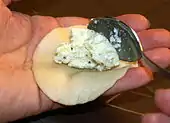 Placing the filling into a dough pocket
Placing the filling into a dough pocket Closing the dough pocket
Closing the dough pocket Sealing the pierogi
Sealing the pierogi
Hungary
In Hungarian cuisine, the derelye is similar to pierogi, consisting of pasta pockets filled with jam, cottage cheese, or sometimes meat.[19] Derelye is consumed primarily as a festive food for special occasions such as weddings; it is also eaten for regular meals, but this tradition has become rare.
Poland

Traditionally considered peasant food, pierogi eventually gained popularity and spread throughout all social classes including nobles. Some cookbooks from the 17th century describe how during that era, the pierogi were considered a staple of the Polish diet, and each holiday had its own special kind of pierogi created. They have different shapes, fillings and cooking methods. Important events like weddings had their own special type of pierogi kurniki – baked pie filled with chicken. Also, pierogi were made especially for mournings or wakes, and some for caroling season in January. Baked pierogi were a typical and the most popular Christmas dish for a long time, especially on the east area. They were stuffed with potatoes, cheese, cabbage, mushrooms, buckwheat or millet. The most famous is the Biłgoraj pierogi stuffed with buckwheat, potatoes and cheese and then baked in the oven[20][21].
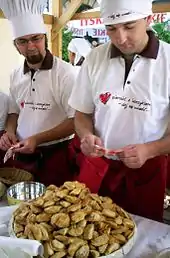
Pierogi are an important part of Polish culture and cuisine today. They are served in a variety of forms and tastes (ranging from sweet to salty to spicy) and are considered to be the national dish.[22] They are served at many festivals, playing an important role as a cultural dish. At the 2007 Pierogi Festival in Kraków, 30,000 pierogi were consumed daily.[23]
Polish pierogi are often filled with fresh quark, boiled and minced potatoes, and fried onions. This type is called in Polish pierogi ruskie, which literally means "Ruthenian pierogi" (sometimes being mistranslated as “Russian pierogi”). Ruskie pierogi are probably the most popular kind of pierogi in North America and Poland. The other popular pierogi in Poland are filled with ground meat, mushrooms and cabbage, or for dessert an assortment of fruits (berries, with strawberries or blueberries the most common).
Sweet pierogi are usually served with sour cream mixed with sugar, and savoury pierogi with bacon fat and bacon bits. Poles traditionally serve two types of pierogi for Christmas Eve supper. One kind is filled with sauerkraut and dried mushrooms, another – small uszka filled only with dried wild mushrooms – is served in clear barszcz.[24] Leniwe pierogi ("lazy pierogi") are a different type of food, similar to lazy vareniki (see below), kopytka, or halušky.
Romania and Moldova
In Romania and Moldova, a similar recipe is called colțunași,[14] with regional varieties such as piroști in Transylvania and Bukovina regions and chiroște in Moldavia region.[25] Colțunași is often a dessert filled with jam (usually plum), fresh sour cherries[26] or cottage cheese, or savoury, filled with dill seasoned cheese (telemea or urdă), mashed potatoes or chopped meat. The dough is made with wheat flour and the colțunași are boiled in salted water,[27] pan-fried in oil or baked in the oven.
The word is a cognate with Slavic kalduny, a type of dumplings. In both Bukovina and Transylvania, the name piroști is used in Romanian families of German or Slavic origin and the filling can also be a whole, fresh, seedless plum. The term colțunaș is used by native Romanian families and are usually filled with cottage cheese or quark and served topped with sour cream smântână, traditionally called colțunași cu smântână.
Russia
Vareniki are widespread in the western and in the Asian regions of Russia. Mostly they are filled in Russia with cherries, quark, fruits, wild berries, blueberries, potatoes, cabbage or beef.[28][29]
Slovakia
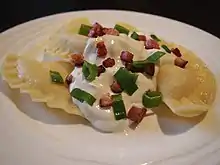
A traditional dish in Slovak cuisine is bryndzové pirohy, dumplings filled with salty bryndza cheese mixed with mashed potatoes. bryndzové pirohy are served with some more bryndza (mixed with milk or sour cream, so it has a liquid consistency and serves as a dip) and topped with bacon or fried onion. In Slovakia, pirohy are semicircular in shape.
Along with bryndzové halušky, bryndzové pirohy is one of Slovakia's national dishes.
Slovenia
Ajdovi krapi (literally buckwheat carps) are a dish popular in the northeastern and Alpine regions of Slovenia. Made with buckwheat rather than wheat flour and filled with a mixture of cottage cheese (skuta), millet, and fried onions, they are traditionally topped with pork fat crisps, fried bacon or fried onion, but today often with butter breadcrumbs.[30] Along with žganci and štruklji, they form a trio of buckwheat-based dishes typical of Slovenian cuisine.
Ukraine
Varenyky in Ukraine are a popular national dish, served both as a common everyday meal and as a part of some traditional celebrations, such as Christmas Eve Supper, Ukrainian: Свята вечеря (Sviata Vecheria, literally Holy Supper). In some regions in or bordering modern-day Western Ukraine, particularly in Carpathian Ruthenia and Galicia, the terms varenyky and pyrohy are used to denote the same dish. The names petahe and pyrohy are also common among Canadian Ukrainians. This can be attributed to the history of Ukrainian and Rusyn immigration to Canada, which came not from the Russian Empire, but predominantly from the former Austria-Hungary, where the local dialects had many common words with Polish, German, Romanian, and other Central European languages.
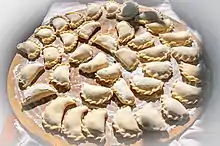
In other regions of Ukraine, the names pyrohy and pyrizhky refer to baked pies and buns as opposed to the boiled dumplings. The name of a popular type of Polish pierogi, pierogi ruskie ("Ruthenian pierogi"), is related to Rus', the historical region and naming of Eastern Slavs and the ancient kingdom from which Ukrainians descend.
Varenyky are considered by Ukrainians as one of their national dishes and plays a fundamental role in Ukrainian culture. Contrary to many other countries that share these dumplings, Ukrainians tended to use fermented milk products (Ukrainian: kysle moloko or Ryazhanka) to bind the dough together; however, today eggs tend to be used instead. Typical Ukrainian fillings for varenyky include cottage cheese, potato, boiled beans, mushy peas, sauerkraut, plum (and other fruits), potato and cheese, cabbage, meat, fish, and buckwheat.
In Ukraine varenyky are traditionally eaten with sour cream (Ukrainian: сметана (smetana)) and butter, as well as with fried onions and fried pieces of bacon and pork fat (Ukrainian: shkvarky). Whilst traditionally savoury, varenyky can also be served as a dessert by simply substituting the filling of the dumpling to a sweeter one. Dessert varenyky fillings include sour cherry, blueberries, sweet cottage cheese, billberies and other fruits. The central regions of Ukraine are known for their more unusual varenyky, Poltava being known for its flour varenyky filling, in which the dumplings are filled with a mixture of flour, lard and fried pieces of bacon.
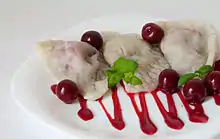
Varenyky are so beloved in Ukraine that a yearly festival commemorating them is held at the Ukrainian ski resort town of Bukovel in the Carpathian Mountains. In 2013 a snow monument to varenyky was made in Bukovel, and was submitted to the Guinness Book of Records as the biggest snow varenyk in the world.
In Ukraine varenyky are not just a national dish, but also played a symbolic and ritualistic role. Ukrainian ancestors equated varenyky with a young moon since they have a similar shape, and used the dumplings as part of pagan and sacrificial rituals. For example, cheese varenyky would be sacrificed near water springs, and years ago Ukrainian peasants also believed that varenyky helped bring a rich harvest, so they took homemade dumplings with them to the fields.[31]
German-speaking countries and regions
.JPG.webp)
The common term Pirogge (pl. Piroggen) describes all kinds of Eastern European filled dumplings and buns,[32] including pierogi, pirozhki and pirogs. Certain types of piroggen, both boiled and baked, were common fare for Germans living in Eastern Europe and the Baltic are still prepared by their descendants living there and in Germany. In particular, baked pīrādziņi are known as Kurländer Speckkuchen ("Courland bacon/speck pies") in the cuisine of Baltic Germans.[33]
Schlutzkrapfen closely resemble pierogi; they are common in Tirol and northern Italy's German-speaking region of South Tyrol, and are occasionally found in Bavaria.[34] Fillings may include meat or potatoes, but the most widespread filling is a combination of spinach and quark (Topfen) or ricotta.[35] Another similar Austrian dish, known as Kärntner Nudel (Carinthian noodles), is made with a wide range of fillings, from meat, mushrooms, potato or quark to apples, pears or mint.[36] These regional specialties differ significantly from the most common Swabian filled dumplings known as Maultaschen.[37]
United States and Canada
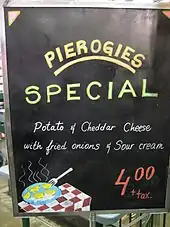
Pierogi were brought to the United States and Canada by Central and Eastern European immigrants. They are particularly common in areas with large Polish or Ukrainian populations, such as Pittsburgh, Chicago, and New York City along with its New Jersey suburbs.[38] Pierogi were at first a family food among immigrants as well as being served in ethnic restaurants. In the post–World War II era, freshly cooked pierogi became a staple of fundraisers by ethnic churches. By the 1960s, pierogi were a common supermarket item in the frozen food aisles in many parts of the United States and Canada, and are still found in grocery stores today.
Numerous towns with Central and Eastern European heritage celebrate the pierogi. The city of Whiting, Indiana, celebrates the food at its Pierogi Fest every July.[24] Pierogis are also commonly associated with Pittsburgh, Pennsylvania especially, where there is a "pierogi race" at every home Pittsburgh Pirates baseball game. In the race, six runners wearing pierogi costumes race toward a finish line. In 1993, the village of Glendon in Alberta, erected a roadside tribute to this culinary creation: a 25-foot (7.6 m) fibreglass perogy (preferred local spelling), complete with fork.[39]
The United States has a substantial pierogi market because of its large Central and Eastern European immigrant populations. Unlike other countries with newer populations of European settlers, the modern pierogi is found in a wide selection of flavors throughout grocery stores in the United States. Many of these grocery-brand pierogi contain non-traditional ingredients to appeal to American tastes, including spinach, jalapeño and chicken.
Pierogi enjoyed a brief popularity as a sports food when Paula Newby-Fraser adopted them as her food of choice for the biking portion of the 1989 Hawaii Ironman Triathlon.[40] For more than a decade thereafter, Mrs. T's (the largest American pierogi manufacturer) sponsored triathlons,[41] some professional triathletes and "fun runs" around the country. For many triathletes, pierogi represented an alternative to pasta as a way to boost their carbohydrate intakes.[42]
According to pierogi manufacturer Mrs. T's, based in Shenandoah, Pennsylvania, pierogi consumption in the United States is largely concentrated in a geographical region dubbed the "Pierogi Pocket", an area including New York, New Jersey, Pennsylvania, Ohio, Indiana, Chicago, Detroit, parts of the northern Midwest and southern New England which accounts for 68 percent of annual US pierogi consumption.[43]
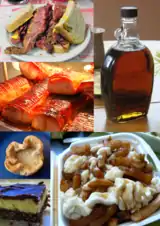 |
| Part of a series on |
| Canadian cuisine |
|---|
|
Canada has a large Polish population, as well as Ukrainian populations, and pierogi are common throughout the country. The Canadian market for pierogi is second only to that of the U.S. market, the latter having been the destination of choice for the majority of Central and Eastern European immigrants before and during World War II.[39]
Packed frozen pierogi can be found wherever Central and Eastern European immigrant communities exist and are generally ubiquitous across Canada, even in big chain stores. Typically frozen flavours include analogs of ruskie pierogi filled with potato and either Cheddar cheese, onion, bacon, cottage cheese or mixed cheeses. Home-made versions are typically filled with either mashed potatoes (seasoned with salt and pepper and often mixed with dry curd cottage cheese or cheddar cheese), sauerkraut, or fruit. These are then boiled, and either served immediately, put in ovens and kept warm, or fried in oil or butter. Popular fruit varieties include strawberry, blueberry, and saskatoon berry.
Potato and cheese or sauerkraut versions are usually served with some or all the following: butter or oil, sour cream (typical), fried onions, fried bacon or kielbasa (sausage), and a creamy mushroom sauce (less common). Some ethnic kitchens will deep-fry perogies; dessert and main course dishes can be served this way. A good method is to par-boil the dumplings, then after drying, they are pan fried or deep-fried.
The frozen varieties are sometimes served casserole-style with a mixture of chopped ham, onions, peppers and cheddar cheese or with an Italian-style mixture of ground beef, onions and tomato sauce.[44]
National chain restaurants in Canada feature the dish or variations. Boston Pizza has a sandwich and a pizza flavoured to taste like perogies, while Smitty's serves theirs as an appetizer deep-fried with a side of salsa.
Lazy pierogi and lazy varenyky
Lazy varenyky (Ukrainian: книдлі, ліниві вареники, Russian: ленивые вареники) in Ukrainian and Russian cuisine or leniwe pyrohy in Rusyn are gnocchi-shaped dumplings made by mixing domashniy sir (curd cheese) with egg and flour into quick dough. The cheese-based dough is formed into a long sausage about 2 cm thick, which is cut diagonally into gnocchi, called halushky in Ukrainian and Rusyn, galushki in Russian. The dumplings are then quickly boiled in salted water and served with sour cream or melted butter. The name "lazy varenyky" faithfully reflects the very quick preparation time of the dish: It usually takes 10 to 15 minutes from assembling the simple ingredients to serving the cooked dumplings.[45] Lazy varenyky differ from standard varenyky in the same way that Italian gnocchi differ from ravioli or tortellini: these are fluffy solid dumplings, not stuffed pockets of dough. The same dish in Polish cuisine is called lazy pierogi (Polish: leniwe pierogi).
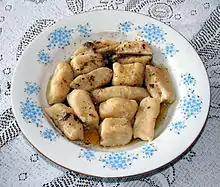 Lazy varenyky Polish style, garnished with cinnamon
Lazy varenyky Polish style, garnished with cinnamon
In culture
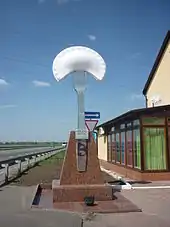
Pierogi have their own patron saint: "Święty Jacek z pierogami!" (St. Hyacinth and his pierogi!) is an old Polish expression of surprise, roughly equivalent to the English language "good grief" or American "holy smokes!" The origin of this expression is unknown.[46]
In Ukrainian literature varenyky appeared as a symbol of national identity, sometimes stressing its distinction from Russian. In the poem by Stepan Rudansky Varenyky-Varenyky (1858), a Russian soldier asks a Ukrainian countrywoman to cook varenyky for him. However, he cannot think of the word "varenyky", while the woman pretends not to understand him.[47]
The Great Pittsburgh Pierogi Race N'at, commonly called the Great Pierogi Race, is an American mascot race between innings during a Pittsburgh Pirates baseball game that features six contestants racing in giant pierogi costumes: Potato Pete (blue hat), Jalapeño Hannah (green hat), Cheese Chester (yellow hat), Sauerkraut Saul (red hat), Oliver Onion (purple hat), and Bacon Burt (orange hat).
Monuments
A monument to varenyky (right) was inaugurated in Cherkasy, Ukraine in September 2006.[48] The monument erected at the entrance to a hotel shows Cossack Mamay (a Ukrainian folklore hero whose fondness for varenyky was narrated by Taras Shevchenko and Nikolay Gogol) eating varenyky from an earthenware pot, with a huge crescent-shaped varenyk behind him.
A monument to halushky was inaugurated in Poltava, Ukraine in 2006.[49] In 1991, a giant pierogi on a fork was erected in the village of Glendon in Alberta, Canada.[50] The statue is 7.6 m (24.9 ft) tall. In January 2010, a pierogi statue was proposed to be erected in Minneapolis, Minnesota.[51]
See also
Notes
- In English, the word pierogi and its variants perogi, pyrogy, perogie, perogy, pirohi, piroghi, pirogi, pirogen, pierogy, pirohy, pyrogie, and pyrohy, are pronounced with stress on the letter "o".
- Among them: Poland, Hungary, Lithuania, Slovakia, Slovenia and Ukraine
References
- Sheraton, Mimi (13 January 2015). 1,000 Foods To Eat Before You Die: A Food Lover's Life List. Workman Publishing. p. 420. ISBN 978-0-7611-8306-8. Retrieved 2 November 2020.
- Sheen, Barbara (20 September 2011). Foods of Poland. Greenhaven Publishing LLC. p. 24. ISBN 978-0-7377-6125-2. Retrieved 2 November 2020.
- Ivan Andreyevsky, ed. (1890–1907), Энциклопедический словарь Брокгауза и Ефрона : Вареники (in Russian), СПб (St. Petersburg), Brockhaus and Efron Encyclopedic Dictionary : Varenyky. The dish was classified as "малороссийский" (malorossiyskiy, Little Russian), with "Малороссия" (Malorossiya, Little Russia) being at that time a common geographical term referring to the territory of modern-day Ukraine.
- "Вареники", Українські страви, Киев: Державне видавництво технiчної лiтератури УРСР, 1960 ("Varenyky", Ukrainian Dishes (in Ukrainian), Kiev: State publishing house for technical literature of Ukrainian SSR, 1960)
- Л. М. Безусенко (ред.) (2002), "Вареники", Українська нацiональна кухня, Сталкер (L. M. Bezussenko, ed. (2002), "Varenyky", Ukrainian Ethnic Cuisine (in Ukrainian), Stalker Publishers)
- William Pokhlyobkin (Russian: В. В. Похлёбкин) (2000), Кулинарный словарь от А до Я : Вареники [Dumplings, Culinary Dictionary from A to Z: Varenyky] (in Russian), Centrpoligraf (Центрполиграф), retrieved 3 October 2015
- Kopka, Deborah (2011). Welcome to Poland: Passport to Eastern Europe & Russia. Milliken Publishing Company. p. 76. ISBN 9780787727734. Retrieved 29 July 2020.
- Severson, Kim (2018-06-26). "A Guide to Soft Fresh Cheeses: Cottage Cheese, Mascarpone and More (Published 2018)". The New York Times. ISSN 0362-4331. Retrieved 2020-11-06.
- Food Culture in Russia and Central Asia, 2005, p 75, By Glenn Randall Mack, Asele Surina
- "varenyky". Canadian Oxford Dictionary. Oxford University Press. 2005. ISBN 9780191735219.
- Voth, Norma Jost (1994). Mennonite Foods and Folkways from South Russia. Good Books International. p. 215. ISBN 1561481378. Retrieved 5 September 2020.
- Brednich, Rolf Wilhelm (1977). Mennonite Folklife and Folklore: A Preliminary Report. National Museums of Canada. Retrieved 5 September 2020.
- "Bryndza Pierogi (Bryndzové Pirohy) recipe - Slovak Cooking". www.slovakcooking.com. Retrieved 2016-07-27.
- "COLŢUNÁŞ" (in Romanian). DEX on line.
- Paluch, Marta. "O cudach św. Jacka, który karmił krakowian pierogami". Retrieved 2016-07-13.
- "Polish Food 101 ‒ Pierogi | Artykuł | Culture.pl". Retrieved 2016-07-27.
- Shelby Pope. "The dumpling that comforts Poland". Retrieved 2020-12-26.
- Bacon, cheese, onion and mushroom topping for fried pierogi Archived 2013-08-31 at the Wayback Machine from urbancookingguide.com
- Derelye recipe from chew.hu
- "Pierogi nowodworskie".
- "Baked pierogi".
- Mark Salter, Gordon McLachlan, Jonathan Buckley. Poland: the rough guide, 1991 and Joey Porcelli, Clay Fong. The Gyros Journey: Affordable Ethnic Eateries Along the Front Range, 2006]
- "Pierogi Festival". rove.me.
- "Annual Pierogi Festival in Whiting, Indiana". Pierogi Fest.
- http://www.libbyzay.com/daytoday/2011/05/recipes-sunday-dinner-moldovan/%7CRecipes%5B%5D from Abroad: Sunday Dinner in Moldova
- culinar. "Coltunasi cu visine si sos". Retrieved 24 August 2016.
- "Hai la masa!: Coltunasi". 7 October 2009. Retrieved 24 August 2016.
- Kharzeeva, Anna (2014-05-08). "Vareniki: A blessing for vegetarians". Retrieved 2018-07-24.
- Bylinka, Ekaterina And Liudmila (2011). Home Cooking from Russia: A Collection of Traditional, Yet Contemporary Recipes. AuthorHouse. p. 98. ISBN 9781467041362.
- A sample recipe (in Slovenian) at the Delo newspaper site
- "Ten Astonishing Facts About Ukrainian Varenyky".
- "Pirogge". Duden Wörterbuch. Dudenverlag.
- Nadia Hassani (2004). Spoonfuls of Germany: Culinary Delights of the German Regions in 170 Recipes. Hippocrene Books. ISBN 9780781810579.
- Alfons Schuhbeck (2012). Meine Klassiker (in German). Gräfe Und Unzer. ISBN 9783833831768.
- Jeremy Nolen & Jessica Nolen (2015). Schlutzkrapfen, the twin of one of Poland's most recognizable food exports. New German Cooking: Recipes for Classics Revisited. Chronicle Books. pp. 178–179. ISBN 978-1452136486. Retrieved 3 October 2015.
- Lia Miklau (1984). Kärntner Kochbüchl. Klagenfurt: Verlag Johannes Heyn. ISBN 3-85366-202-1.
- Mimi Sheraton (2010). Maultaschen. The German Cookbook: A Complete Guide to Mastering Authentic German Cooking. Random House Publishing Group. pp. 115–. ISBN 978-0307754578. Retrieved 3 October 2015.
Dumplings are to the German cuisine what pasta is to the Italian.
- Barber, Casey (2015). Pierogi Love: New Takes on an Old-World Comfort Food. Gibbs Smith. pp. 11–12. ISBN 9781423640660. Retrieved 30 July 2020.
- "World's Largest Pierogi" Archived 2012-03-11 at the Wayback Machine in Glendon, Alberta, from bigthings.ca
- Carter, Tom (27 September 1990). "Pierogies replace pasta in popularity". Washington Times. p. D2.
- Mrs. T's Triathlon Archived 2008-12-06 at the Wayback Machine, Chicago (2000), from active.com
- Stein, Ricki (10 April 1991). "High-Carbo Pierogies Score Points With Triathletes". The Morning Call. p. D1.
- "Mrs T's Pierogy Pocket Capital of America". Archived from the original on 3 March 2016. Retrieved 24 August 2016.
- Perfect Perogy Casserole Archived 2010-09-19 at the Wayback Machine from Cheemo Recipes Page www.cheemo.com
- Lazy vareniki: recipe, preparation, and serving suggestion.
- Polish Heritage Cooker by Robert Strybel, Maria Strybel, 2005 p. 456
- Степан Васильович Руданський, Вареники-вареники Archived 2015-10-03 at the Wayback Machine. 1-я публикация в еженедельнике Русский мир, № 21, с. 504 (Stepan Rudansky. Varenyky-Varenyky. First publication in weekly newspaper Russian World, 21, p. 504, 1859; in Ukrainian)
- A monument to vareniki in Cherkasy, Ukraine (in Russian); also see a news item on gpu.ua, 27 September 2006 (in Ukrainian).
- A monument to halushky in Poltava, Ukraine.
- "Giant perogy in Glendon, Alberta". Bigthings.ca. Archived from the original on 2012-03-11. Retrieved 2012-05-17.
- "Artist hopes a pierogi will rise in Northeast". Startribune.com. 2010-01-23. Archived from the original on 2012-10-11. Retrieved 2012-05-17.
External links
 The dictionary definition of pierogi at Wiktionary
The dictionary definition of pierogi at Wiktionary The dictionary definition of varenyky at Wiktionary
The dictionary definition of varenyky at Wiktionary- The Pierogi Renaissance: How Poland's Most Famous Dish is Reinventing Itself